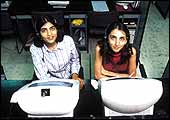|
 The
Wadias. The Kirloskars. The Hirachands. They were names that ran
India Inc. pre-1990s. It was an era of grand, old names with grander
histories. The Wadias of Bombay Dyeing were descendants of Nowrosjee
Nusserwanji Wadia, one of India's earliest industrialists. The Kirloskars
were descendants of Laxmanrao Kirloskar, the first Indian to produce
modern farm equipment. The Hirachands were descendants of Walchand
Hirachand, whose shipping company was one of the first Indian businesses
to confront the imperialists of the British Raj. The
Wadias. The Kirloskars. The Hirachands. They were names that ran
India Inc. pre-1990s. It was an era of grand, old names with grander
histories. The Wadias of Bombay Dyeing were descendants of Nowrosjee
Nusserwanji Wadia, one of India's earliest industrialists. The Kirloskars
were descendants of Laxmanrao Kirloskar, the first Indian to produce
modern farm equipment. The Hirachands were descendants of Walchand
Hirachand, whose shipping company was one of the first Indian businesses
to confront the imperialists of the British Raj.
How much has changed within a decade. The 1990s
and liberalisation ensured that history, personal wealth, and pedigree
were passe. Many of the business families that used to dominate
the who's who lists began to disappear in the decade of transformation.
The new business ethos dictated that profitability and shareholder
wealth came above all else. It is an ethos born from a new democracy,
a new plurality, in business. The greatest strength of the old groups
in the control era-their lineage-became their greatest problem.
It was no longer enough to be a domestic fat cat ensconced in a
cosy family group. There were nimble, rapacious new dogs of war
let loose by liberalisation and the age of the individual.
The 1990s unleashed a wave of pent-up entrepreneurism
among the unlikeliest of people. From sweathouse software coders
to fitters in gasket factories, from the urban professional to the
semi-educated small towner, they all saw their chance. Sapped of
opportunities by the control economy, the great, growing Indian
middle class eagerly grabbed its chances.
The liberalisation of 1991 brought a more democratic
system of business. It marked the end of license-permit raj, protection,
subsidies and ceilings on asset size. Terms like competition, core
competency, strategic planning, professional management, and entrepreneurship
came into vogue. The liberalisation package announced by the then
Finance Minister Manmohan Singh greatly increased the velocity of
business. It no longer took months or years and umpteen visits to
Delhi to get a licence for a biscuit factory.
The new democracy extended to finance as well.
Equity became a viable financing option. With the abolition of the
Controller of Capital Issues, market pricing of equities became
possible. In fact the early 1990s marked a frantic escalation for
the primary market in India; it was dampened by the 1992 Harshad
Mehta scam, but rebounded. The entry of foreign investors also provided
much needed capital. Government removed restrictions on foreign
exchange for things such as opening offices abroad and hiring foreign
consultants. That was a huge boost for the infotech sector. The
rise of the professional entrepreneur, the birth of the knowledge
entrepreneur and the acceleration in the services sector were all
hallmarks of this decade.
As the tempo picked up, financing became even
easier. The entry of venture capitalists added to the excitement.
The new-gen entrepreneurism spawned myriad businesses in software,
multimedia, telecom, retail, internet, biotech, professional services,
and other knowledge intensive areas. It reached a frenetic pace
at the end of the decade with the venture capitalist desperately
looking for ideas at which to throw money. That released the dotcom
generation, which in a mad rush to cash in tried to turn the laws
of business on their head. It was bound to fail, but it imbibed
India with more determination than its conservative mindset had
ever seen before.
The last time India had witnessed a burst in
entrepreneurism was in the 1950s. That was in the heady days after
independence. Businessmen worked in conjunction with the government
to help build Nehru's temples of industry and self-reliant India.
The energy was quickly suppressed by a confused socialism.
The 1990s were a different era. The government
had failed in most areas it did business in. The old families generated
wealth chiefly for themselves. It was also a decade with no unified
centre. Cooperation and coalition were the driving points in politics,
but so was polarisation: each one for himself. From this unlikely
mix was born the age of the entrepreneur.
-Seema Shukla
The New Women In Our Lives
 |
| Khemlani: Not much competition cleaning skyscrapers |
 |
| Swarup and Sapra: No one asks for the boss any
more |
 |
| Hussain: Empress of a self-made multicrore herbal
empire |
By Indian standards,
you couldn't accuse Ishita Swarup's parents of being conservative.
They watched with pride as Swarup got her MBA and later a cushy
job managing brands Cadbury India. But when she and friend Tina
Sapra, an advertising professional, decided to quit their jobs and
become entrepreneurs in 1992-they were both in their mid 20s-Swarup's
father, a government servant, threw a fit. "My father threatened
to disown me," she recalls today with a smile. Entrepreneurism
was itself new at the start of the decade, the concept of women
entrepreneurs was newer still. Today Swarup and Sapra's call centre
in Delhi employs 220 employees and is a Rs 3 crore business, and
growing. Prospective customers no longer ask if they can meet the
boss. Their parents couldn't be prouder.
The double whammy for the woman entrepreneur
is fading fast. And women know it. "There is something in the
atmosphere that is changing," says Revathi Kasturi, 41, President,
Tarang Software. "Even society is more supportive. After 20
years in the Indian it industry, 18 of them with the largest of
them all, Wipro, Revathi Kasturi (B. Tech, IIT Mumbai, class of
1980) rose to be chief executive of Wipro's system integration division,
then doing business worth $50 million. In March 2000, single, supporting
a daughter and mother, she set up Tarang with her techie brother
and another professional.
According to an Ernst & Young study in
2000, entrepreneurial activity among women is nearly half that of
men in India (6.3 per cent). In economies like Canada, Spain and
Brazil the participation of women is only slightly less or equal
to male participation. But the last five to seven years have not
just witnessed a rapid increase in women of enterprise but also
seen a change in the nature of their enterprise. The Federation
of Indian Chambers of Commerce and Industry's ladies organisation
reports a 100 per cent growth in its ranks of women entrepreneurs
in the last five years. The Federation of Indian Women Entrepreneurs
has seen a 35 per cent increase in the same period.
Earlier garment exports, handicrafts, and leather
exports were traditional female domains, then health and beauty
became a bastion. Shahnaz Hussain, daughter of a former Chief Justice
of India, borrowed Rs 35,000 from her father to build her herbal
empire, estimated to be worth Rs 250 crore today.
Today there new fields of dreams. From biotechnology
to skyscraper-cleaning companies, you name it-you will find a woman
running it. There's Kiran Mazumdar, a brewing expert who didn't
find work and set up her own company in 1978. It was in the 1990s
that she really found her forte: biotechnology. Then there are those
like Suhag Khemlani, 24, who decided in 1998 to make her living
cleaning India's new skyscrapers. "I faced a lot of attitude
initially from people reluctant to take orders from a girl,"
she says. "Now they realise I can compete with the best."
-Seema Shukla
Why Salarymen Turned To
Entrepreneurism
 |
| Soota: Taking the last chance |
 |
| Rajam: Keen, able, and willing |
For Ashok Soota,
it was about the last chance. When the monsoon of 1999 swept Bangalore,
he was 56, a vice president in infotech giant Wipro. Firmly middle
age, Soota did seem to have it all. But what he missed above all
was the ability to say, "I did that". Today as his start-up
Mindtree Consulting notches up a turnover of Rs 70 crore-and aims
for Rs 750 crore in the next five years-you could say he used his
last chance to strike out on his own pretty well. Never before has
middle India been struck so virulently by the bug of self-achievement.
Soota was a pioneer in the field, and his example tells you what
drove India's salarymen to entrepreneurism. First, as the nuclear
family splintered in the 1980s, individual achievement came forth.
Second, the loosening hold of bureaucrats and political interests
on business. Third, the coming of the tech age allowed the ambitious
to not just dream but do. And so they did. Aided by that wonderful
new device-venture capital-the rush of professionals to entrepreneurism
became a crescendo. That's how India saw the formerly staid salaryman
willing to pose, dance, and strut for publicity and recognition.
Srini Rajam, 41, conservative former country head and veteran of
Texas Instruments, is proof of the salaryman's new avatar. Rajam
has no qualms garnering attention for his new company, Ittiam Systems.
Uncountable thousands want to be like him.
-Seema Shukla
|

